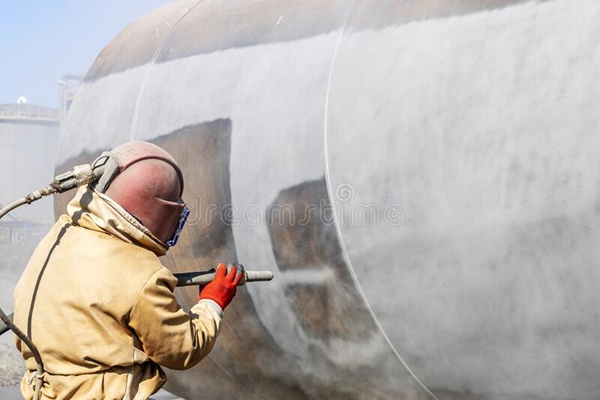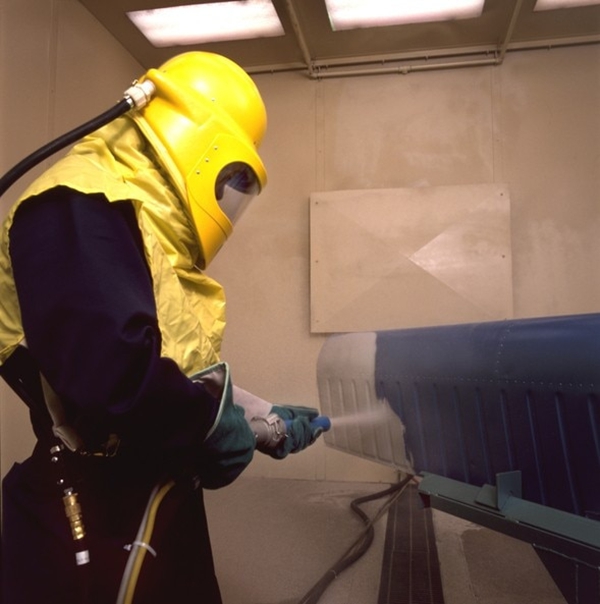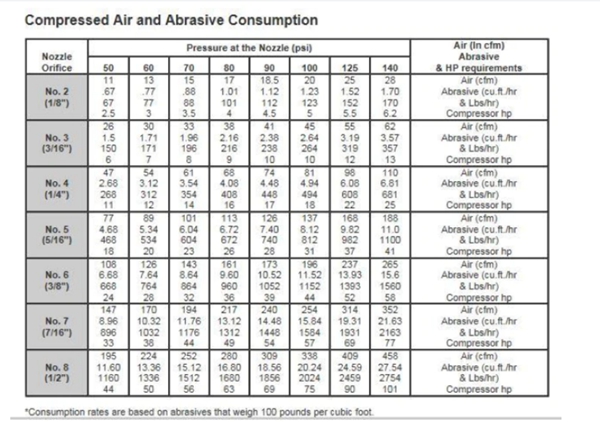
Sand blasting
Sand blasting uses compressed air as the power to make the spray material (copper ore sand, quartz sand, emery sand, iron sand) form a high-speed jet beam, which is jetted to the surface of the object to be treated at high speed, which changes the shape of the surface layer of the object. The high-speed friction of the surface of the object forms an impact and cutting effect on the surface of the object, thereby increasing the cleanliness of the surface of the object, and can form different roughness, improving the shape and performance of the surface of the object, thus improving the friction and resistance of the object Fatigue, increases the adhesion between it and the surface coating, extends the durability of the coating, and is also conducive to the leveling and decoration of the coating.
Sandblasting uses pressurised air to hurtle sand at surfaces, stripping off old paint, rust, dirt, and grease. Either restoring the item to its original condition or preparing the surface for refinishing and repair. The machines are most commonly used in the auto industry, in ship and rail yards and in other industrial applications.
After deciding to sandblast a surface you must choose the correct size air compressor for your job
Compressor For Sandblasting & Abrasive Blasting

Various media, depending on the application, are shot against a surface to change the texture in a process known as abrasive blasting. This process may roughen up or smooth out a surface as well as remove corrosion. In this application, the abrasives are propelled by compressed air, so choosing the correct air compressor is an important step. The compressor must have sufficient airflow for the process to operate smoothly.
What is air compressor sizing?
There's two important metrics you need to know for sizing compressors and sandblasters.
1. CFM (cubic feet per minute)
This is the airflow or air volume that a compressor can supply within a minute. An air compressor which produces between 10CFM – 20 CFM is ideal for smaller sandblasting tasks. While a compressor which produces between 18CFM to 35 CFM is better for larger jobs where a more powerful experience is needed. While an industrial type of sandblasting needs a CFM of 50 – 100.
2. PSI (pounds per square inch):
This is the air pressure generated by the compressor. The tank volume determines how long the compressor can produce air. To find the correct PSI for your job, you'll need to to consider how long you will be running the tool and how many tools you're using at one time on the compressor.
A higher PSI means faster cleaning, while these are more expensive you may feel the cost is worth the time saved. You should use a tank with a minimum of 100 PSI for optimum efficiency. If you reduce your blasting pressure by half, your pressure cleaning project will take four times as long.
You must consider both PSI and CFM numbers to make sure they work together.
What Nozzle Size do I Need?
THE CFM, PSI and Nozzle size all work in unison, so once you have figured out your CFM and PSI, the nozzle size can be chosen. The larger the nozzle, the higher the air pressure and the more air your sandblasting will require.
● No. 2 nozzle at 100 PSI, your air compressor needs to provide a CFM of 20
● No. 2 nozzle at 140 PSI, your air compressor needs to provide a CFM of 28
The size of the nozzle affects the blast pattern, going up one size can increase the size of your blast by 10%. If you are working with a precise area of blasting a smaller blast pattern will be required. A nozzle size of 4 measuring 3/16 inch or nozzle size of 5 measuring 1/16 inch is recommended.
To work more efficiently you'll need a larger nozzle size. Consider nozzle sizes between the range of 6-9 and measuring 3/8 inch to 1/2inch.
It is important to note that nozzles wear out, an old worn-out nozzle requires more volume per minute to maintain the target pressure. You must also increase the size of the compressor for projects with a higher PSI.

Important Compressor Considerations for Abrasive Blasting
● Flow is more important than pressure for this application. The blaster will typically require less than 120 psi which is standard for most air compressors.
● Air directly propels the media used in abrasive blasting, therefore, it may use more air than other applications. Additionally, it may require a larger compressor or one that is able to operate continuously.
● Depending on equipment, the cfm my vary from 6 cfm on a 1/8-inch nozzle to 220 cfm on a 3/8-inch nozzle. (See below sizing chart for sizing and pressure.)
● Many blasters have a listed cfm requirement, while others do not list a required cfm as none is directly required. In the case that no cfm is listed, users will need to use the nozzle as a size guide.
● Over time, the orifice on the nozzle will wear and use more air than originally designed.
● Application Requirements To Consider
● Is oil free air required or is oil-lubrication acceptable? If small amounts of oil in the process is no hindrance, an oil-lubricated compressor is perfectly fine. If oil in the process will affect the final product , an oil free compressor or robust filtration system will be required.
● Is dry air required? Depending on the media used and the orifice, dry air may be critical to continued reliability of the abrasive blasting system. Moisture in the air can cause the blast media to clog the orifice and cause sputtering.
● Is breathing air required? Abrasive blasting sometimes needs a breathing hood to protect the user. It is important to recognize that Grade D Breathing air is necessary, not simply regularly compressed air. Compressed air, even filtered, is no substitute for proper breathing air.
● Equipment Placement: Ideally, the compressor should be installed away from a dusty environment. Abrasive blasting can increase the amount of fine particulate in the air. This should not be introduced into the compressor. An additional pre-filter on the inlet can help prevent damage.
Important safety notes
Before operating an air compressor for sandblasting, ensure you have read the manufacturer's guide and you are complying with all the instructions. While sandblasting wear protective clothing including a dust mask, safety goggles, long sleeve shirt and long pants.








